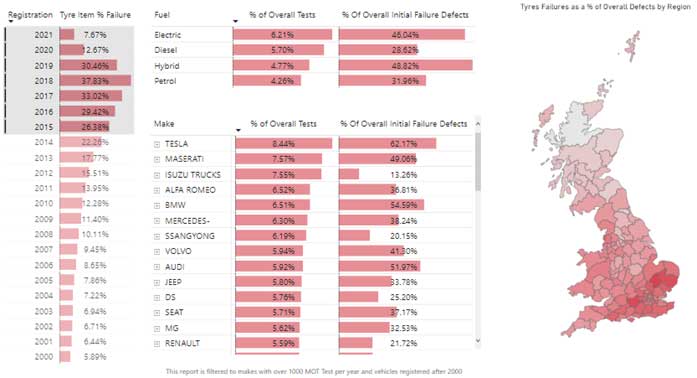IMI Response to MOT Consultation

IMI response to MOT Consultation: Tyres present the greatest risk to road safety if there is any extension to the first MOT date New IMI/Garage Industry Trends analysis shows tyres are the ‘weakest link’ in vehicle condition – with EV tyres experiencing more wear than those for ICE vehicles
In-depth analysis of MOT data
The Institute of the Motor Industry (IMI), which represents more than 90,000 automotive professionals, has conducted in-depth analysis of MOT data in order to formulate a considered and balanced response to the Department for Transport’s MOT Consultation. Working with Garage Industry Trends to examine root causes in current patterns of MOT failure, the IMI analysis provides clear evidence that extending the date for the first MOT will significantly increase road user risk.
In particular the risks surrounding electric vehicles – which are heavier than ICE vehicles and cause heavier wear to their tyres - will be heightened if the first MOT date is extended. Evidence drawn from MOT testing records supplied to the IMI by the Department for Transport shows that comparative to petrol engine vehicles, electric vehicles are much more likely to fail their first MOT test.
EV failure rates for 2018 registered vehicles (all classes) was 11.51%. This is lower than diesel (15.98%) but higher than petrol (10.89%). This pattern holds for 2017 and 2016 registration years. Given that a large proportion of EV owners in 2018 can be classed as enthusiast (early adopters) and would likely maintain their car better than today’s average EV driver, the IMI believes this is a significant finding.
EVs fail more on dangerous items
The data also indicates that EVs fail more on dangerous items than petrol vehicles - primarily being tyres. The data from the Department for Transport shows that looking at the class 4 car parc from 2015 - which would have had their first MOT in 2018 - electric vehicles are 1.95% more likely to fail an MOT test on tyres than petrol vehicles. This is a relative difference of 46%, with Tesla having the highest likelihood of any car make to fail on tyres. 46% of all failure items for electric vehicles are related to tyres, compared to 32% for petrol vehicles.
“This is not about the quality of tyres on cars”, explained Hayley Pells, Policy Manager at the IMI. “It is all about the lack of awareness amongst the general driving public about the importance of routine checking of vehicle condition and tyres in particular.
“Many motorists are likely to believe that they can wait for their first MOT to pick up any issues with tyres. However, the data shows that electric vehicles tend to fail on their tyres more than traditional petrol vehicles. If the first MOT is extended this will be a serious concern for road safety as well as potentially having a significant impact on consumer confidence in electric vehicles, which is unfair as the technology appears to perform well in other areas of current MOT testing.
The IMI’s response to the MOT Consultation
“With the majority of first MOT tests taking place coupled with routine maintenance it is shocking that these figures exist for failure rates at all, suggesting that many of these vehicles have not been subject to routine maintenance that would pick these items prior to MOT test” continued Hayley Pells. “The IMI’s response to the MOT Consultation will therefore strongly advise that increasing the time before a periodic inspection of cars is detrimental for road safety. It reduces the frequency of maintenance and inspections that are critical to ensuring that vehicles are in good condition and performing at their best.”

Figure 1 Tyre analysis for MOT test data compared by powertrain (Garage Industry Trends)
Electric vehicles (EVs) wear their tyres differently to traditional petrol vehicles because of their unique driving characteristics. Some of the reasons for this include:
- Heavier Weight: EVs tend to be heavier than petrol vehicles due to the weight of their batteries. This extra weight puts more stress on the tyres, causing them to wear down faster.
- Torque delivery: Electric motors produce a lot of instant torque in comparison to different power trains, this is particularly wearing on the tyres at a standing start.
In conclusion, EVs tend to use their tyres more quickly than petrol vehicles because of their heavier weight and the delivery of torque by electric motors.
The condition of a vehicle's tyres is critical to safety for several reasons:
- Traction: Tyres provide traction between the vehicle and the road. Worn or damaged tyres can reduce traction, making it harder to control the vehicle, especially in wet or slippery conditions.
- Steering: Tyres also play a critical role in steering. Proper tyre inflation and tread depth are important for maintaining a vehicle's handling and stability. Worn or damaged tyres can make steering more difficult, increasing the risk of accidents.
- Braking: Tyres are a key component of a vehicle's braking system. Tyres with insufficient tread depth or poor condition can reduce the vehicle's ability to stop quickly, increasing the risk of accidents.
- Blowouts: Tyres that are worn or damaged can be more prone to blowouts, which can cause a sudden loss of tyre pressure and create a dangerous situation on the road.





